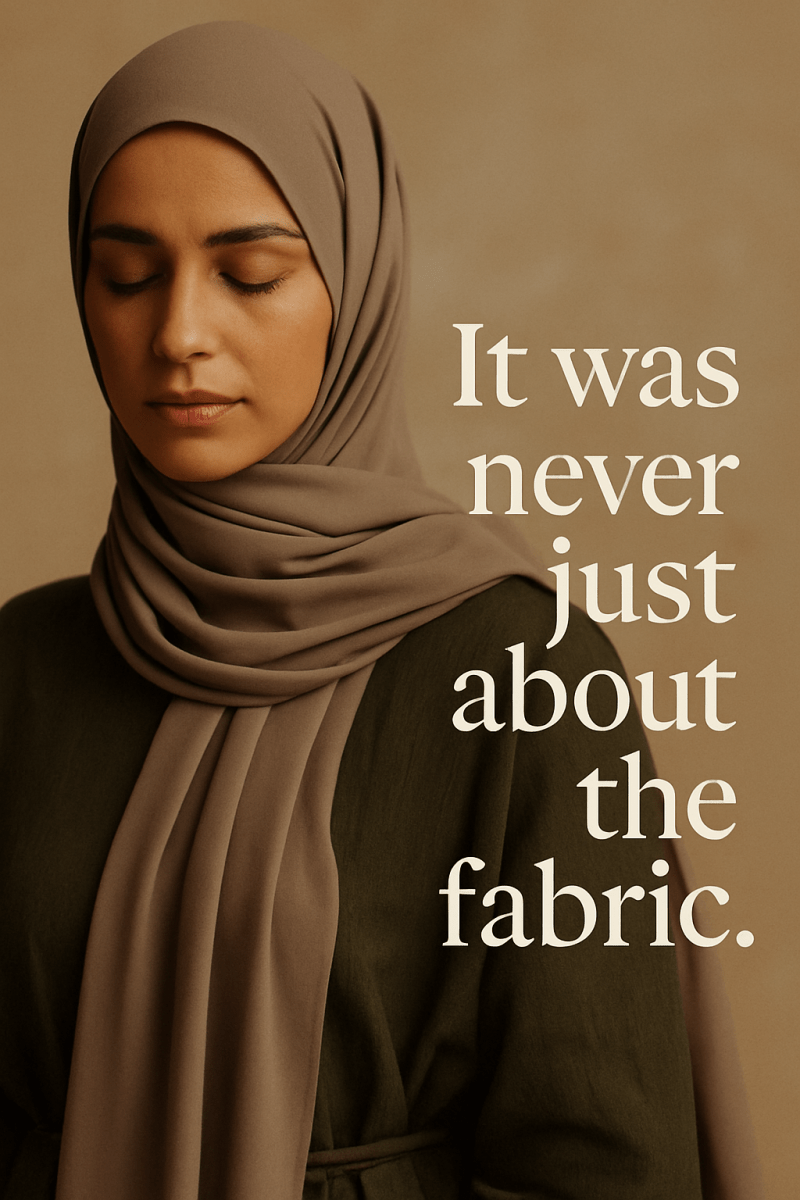
I didn’t grow up hearing the words “modest garments,” but I saw them in the way the women around me carried themselves — with dignity, purpose, and grace. All I knew was the quiet strength I saw in the women around me — the way they carried themselves, the way they covered. No need for loudness. No need to perform. It simply existed in truth. And even before I understood the why, I felt drawn to it.
There’s something sacred in choosing what to reveal and what to reserve. In letting your presence speak before youeer silhouette does. In wrapping yourself in garments that make you feel more like yourself — not less.
So when people talk about modest garments like they’re just long sleeves and extra fabric, I can’t help but feel they’ve missed the point entirely. Because if you’ve ever stood in front of a mirror, adjusted your abaya, and felt a sense of peace wash over you — then you know.
This isn’t about hiding.
It’s about honoring.

What Modest Garments Represent Beyond Style
Sometimes I wish people could hear the silence of modesty.
Because it speaks.
It speaks in how we walk into a room without needing to take it over.
In how we show respect — not just for ourselves, but for the space we occupy.
It’s a kind of stillness. A kind of grace.
For me, wearing modest garments has never been about being noticed — but it has always been about being seen. Not for my shape, not for how closely I can match someone else’s beauty standard — but for my presence, my values, my softness, my strength.
And no, it isn’t always easy. We live in a world that constantly pushes visibility — tighter, louder, shorter, more. But there is courage in restraint. There’s clarity in choosing not to perform.
Modesty, when it’s sincere, becomes a language the heart understands.
And garments — when chosen with care — become part of that language.
Wearing What Reflects You — Not What Distracts From You
There’s a quiet moment I think many of us know too well — standing in front of the closet, holding a piece of clothing, and asking:
Does this feel like me?
Not trendy.
Not flattering by someone else’s standards.
But me — the version of myself that I feel proud to walk the world as.
The first time I wore a linen abaya that moved gently with the wind, I didn’t feel hidden. I felt seen — but on my own terms. No need to adjust, tug, or second-guess whether I was too much or not enough. I was simply present. Covered, comfortable, and deeply myself.
That’s what modest garments give us.
Not a costume. Not a role to play.
But a soft return to who we really are.
And when you start dressing in alignment with your values — your inner world starts to feel more peaceful too. There’s less noise. Less pressure. Just quiet confidence. And sometimes, that’s everything.
As Yaqeen Institute beautifully explores in The Heart of Modesty, modest garments are more than dress — they’re a reflection of one’s connection to Allah, to self, and to community.
What We Choose to Wear Is Also What We Choose to Say
Some pieces become part of us quietly — not because they’re flashy, but because they feel like home.
The soft curve of embroidery near the wrist.
The way a chiffon abaya catches the light when you turn.
The perfect fall of a hijab that doesn’t need constant adjusting.
These details may seem small, but they shape how we move through the world. They tell our story — not through excess, but through care. Through intention.
A light linen abaya on a summer afternoon.
A delicately stitched chiffon hijab for Friday prayers.
A four-piece set that makes you feel quietly regal at a family gathering.
They all carry something more than fabric: they carry meaning.
It’s not about having more. It’s about having pieces that feel right — pieces that speak your language, even when you say nothing at all.
That’s why I’ve come to see modest garments not as limitations, but as possibilities. Each fold, each seam, each quiet color — it’s a reflection. And when chosen with love, it can reflect something far deeper than style.

There’s Strength in Choosing Less — and Meaning in Every Layer
Confidence doesn’t always arrive with noise.
Sometimes, it walks in softly — wrapped in earth tones, delicate folds, and a head held high.
Dressing with intention carries a power that doesn’t need to be announced. Not to impress. Not to compete. But simply to honor who you are, and what you stand for.
Slipping into modest garments often feels like stepping into alignment — the kind that flow, not cling — I feel like I’m meeting the day on my own terms. Approval and attention don’t matter — alignment does.
That alignment shows up in small ways:
- Choosing fabrics that feel like air on the skin
- Picking pieces that let you move freely
- Wrapping your hijab the way you like, not how others expect
There’s nothing accidental about this kind of dressing.
Every layer says, I know who I am. I know what I carry.
And that quiet knowing — that’s the kind of beauty that lasts.
More Than Fabric, More Than Fashion
We talk about clothing like it’s just what we wear. But modest garments — when chosen with care — become something else entirely.
They become quiet teachers. Reminders of who we are when the world wants us to forget. They teach us how to show up without needing to show off. How to move through the world with softness and strength intertwined.
They remind us that beauty doesn’t have to be loud. That dignity doesn’t need decoration. And that faith can live in the folds of a dress — in the stillness of a long sleeve, in the way a hijab is tied before walking out the door.
When I reach for modest garments now, I don’t feel like I’m limiting myself. I feel like I’m returning to myself. Over and over again.
And maybe that’s what this has always been about — not the fabric, but the woman inside it.

